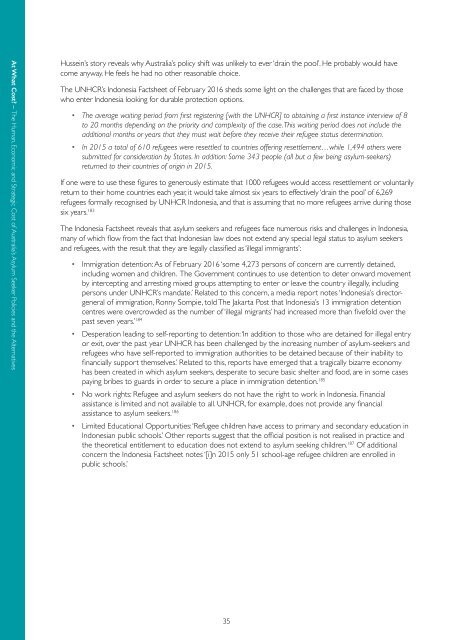AT WHAT COST?
At-What-Cost-Report-Sept-2016
At-What-Cost-Report-Sept-2016
You also want an ePaper? Increase the reach of your titles
YUMPU automatically turns print PDFs into web optimized ePapers that Google loves.
At What Cost? – The Human, Economic and Strategic Cost of Australia’s Asylum Seeker Policies and the Alternatives<br />
Hussein’s story reveals why Australia’s policy shift was unlikely to ever ‘drain the pool’. He probably would have<br />
come anyway. He feels he had no other reasonable choice.<br />
The UNHCR’s Indonesia Factsheet of February 2016 sheds some light on the challenges that are faced by those<br />
who enter Indonesia looking for durable protection options.<br />
• The average waiting period from first registering [with the UNHCR] to obtaining a first instance interview of 8<br />
to 20 months depending on the priority and complexity of the case. This waiting period does not include the<br />
additional months or years that they must wait before they receive their refugee status determination.<br />
• In 2015 a total of 610 refugees were resettled to countries offering resettlement…while 1,494 others were<br />
submitted for consideration by States. In addition: Some 343 people (all but a few being asylum-seekers)<br />
returned to their countries of origin in 2015.<br />
If one were to use these figures to generously estimate that 1000 refugees would access resettlement or voluntarily<br />
return to their home countries each year, it would take almost six years to effectively ‘drain the pool’ of 6,269<br />
refugees formally recognised by UNHCR Indonesia, and that is assuming that no more refugees arrive during those<br />
six years. 183<br />
The Indonesia Factsheet reveals that asylum seekers and refugees face numerous risks and challenges in Indonesia,<br />
many of which flow from the fact that Indonesian law does not extend any special legal status to asylum seekers<br />
and refugees, with the result that they are legally classified as ‘illegal immigrants’:<br />
• Immigration detention: As of February 2016 ‘some 4,273 persons of concern are currently detained,<br />
including women and children. The Government continues to use detention to deter onward movement<br />
by intercepting and arresting mixed groups attempting to enter or leave the country illegally, including<br />
persons under UNHCR’s mandate.’ Related to this concern, a media report notes ‘Indonesia’s directorgeneral<br />
of immigration, Ronny Sompie, told The Jakarta Post that Indonesia’s 13 immigration detention<br />
centres were overcrowded as the number of ‘illegal migrants’ had increased more than fivefold over the<br />
past seven years.’ 184<br />
• Desperation leading to self-reporting to detention: ‘In addition to those who are detained for illegal entry<br />
or exit, over the past year UNHCR has been challenged by the increasing number of asylum-seekers and<br />
refugees who have self-reported to immigration authorities to be detained because of their inability to<br />
financially support themselves.’ Related to this, reports have emerged that a tragically bizarre economy<br />
has been created in which asylum seekers, desperate to secure basic shelter and food, are in some cases<br />
paying bribes to guards in order to secure a place in immigration detention. 185<br />
• No work rights: Refugee and asylum seekers do not have the right to work in Indonesia. Financial<br />
assistance is limited and not available to all. UNHCR, for example, does not provide any financial<br />
assistance to asylum seekers. 186<br />
• Limited Educational Opportunities: ‘Refugee children have access to primary and secondary education in<br />
Indonesian public schools.’ Other reports suggest that the official position is not realised in practice and<br />
the theoretical entitlement to education does not extend to asylum seeking children. 187 Of additional<br />
concern the Indonesia Factsheet notes ‘[i]n 2015 only 51 school-age refugee children are enrolled in<br />
public schools.’<br />
35


